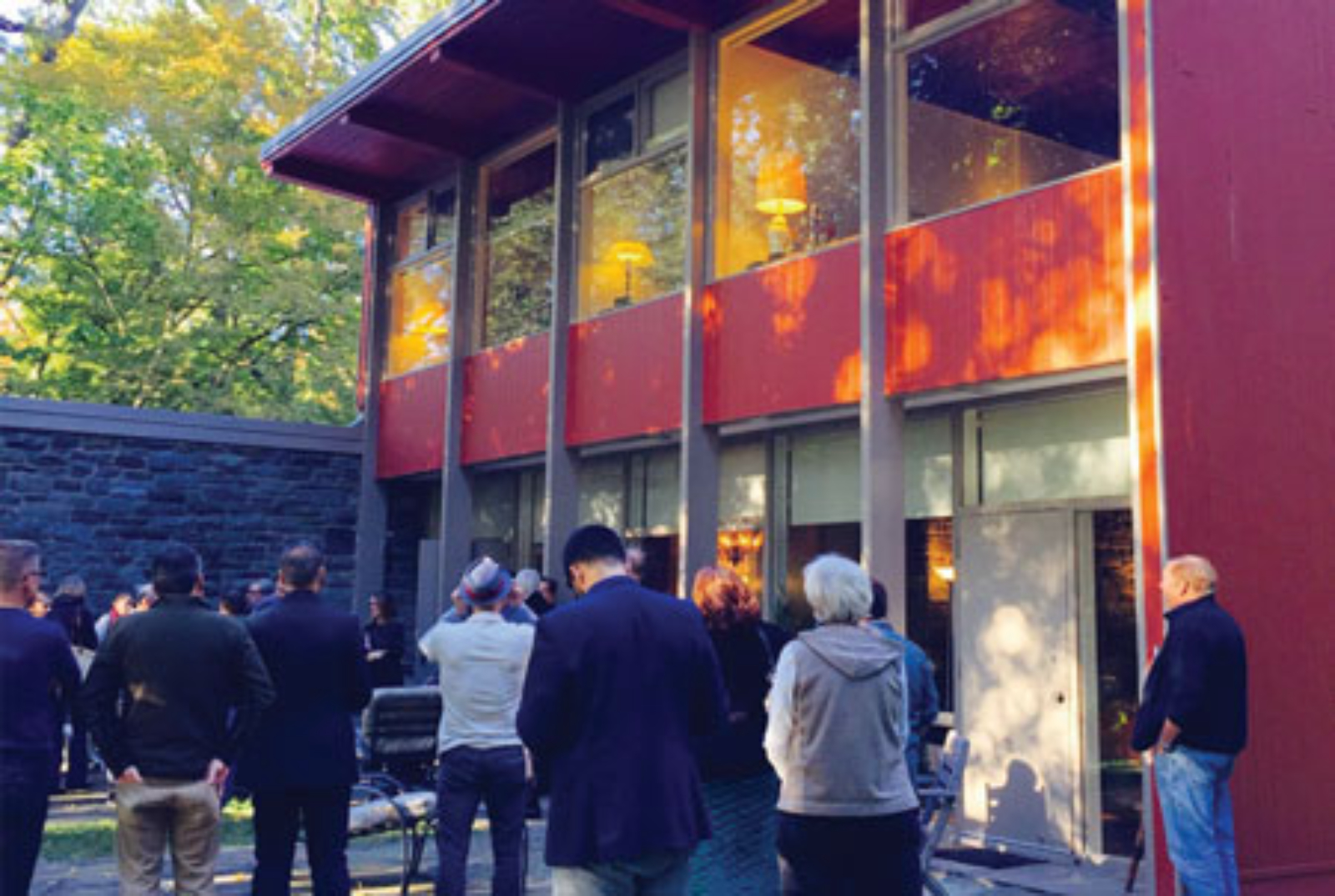By Daniel Vieyra and Grace Ong Yan, President of Docomomo-US Greater Philadelphia, and adapted from the event brochure, Vincent Kling: Houses, written and designed by Daniel Vieyra with graphics by Karen Ramsey
On October 15, 2017, Docomomo US-Greater Philadelphia ran a successful tour, Vincent Kling: Houses that was months in the making. The sold out event was organized by board member, Daniel Vieyra, Ph.D., AIA. Vincent Kling: Houses was attended by fifty modern enthusiasts including architectural historians, architects, designers, and modern homeowners. It was part of both Docomomo's National Tour Day 2016 and DesignPhiladelphia.
View of Scull House. Credit: Grace Ong Yan
The three houses on the tour highlight Vincent Kling's oeuvre of domestic design, a side of the architect's repertoire that has been gravely understudied. Kling is most associated with large-scale urban reconfiguration and it attendant heroic, often severe architecture, which is seldom thought of in connection with humane modernism and the post-war era's search for a new domestic paradigm. Kling's initial profession recognition came for his houses, whose unique combination of strict modernist precepts with qualities that reflected American popular culture. This simultaneous appeal to both the high and low brow is exemplified by the inclusion of his Peaslee Beach House in both the Museum of Modern Art's "Built in the USA: 1932-1944", and in post-war magazine ads touting the optimistic sense of youth and sunshine associated with driving the "futuramic" rocket-action Oldsmobile.
For Tour Day, we visited the three houses in reverse chronological order, that is, from the most recent to the earliest. First, we visited the Smith, now Saul, House of 1958. The Smith House features shed roofed, clerestory punctuated pods that are unified by a geometrically rigorous flowing plan that features terraces and exterior spaces that extend and flow to the outside in a manner that marks the culmination of Kling's experimentation with open plans.

Courtesy of k YODER design, © Jeffrey Totaro, Photographer
Architect Kevin Yoder, principal of kYODER design, who meticulously restored the house a few years ago, gave a presentation of how he approached the project. He guided us through aspects of preservation and the challenges of restoring a mid-century modern house. Yoder also showed us how sensitive updates, especially in the kitchen and master bath areas, can remain true to the spirit of mid century modern houses while preserving them for the next generation of family to enjoy.
 Smith (Saul) House. Credit: Grace Ong Yan
Smith (Saul) House. Credit: Grace Ong Yan
The second house we toured was the Line, now Rogoff/Ginensky, House, built in 1954 and commissioned by commercial artist Lemuel B. Line as his family home and studio. Best known for his art for the Container Corporation of America, Line was recognized by the Museum of Modern Art in 1947 for his work that featured the relationships and architectural abstractions of man and nature. Though built in what was then a rural setting, this house is noteworthy for its relationship to the street. A series of interior, exterior, and transitional spaces establish a progression of privacy as one moves away from the street; the dramatic carport at once screens and features the car, providing a buffer between the street and family areas. Perhaps Kling's most relaxed and overtly domestic work, the house is capped by a broad gable roof that subsumes the whole, while retaining the autonomy of its primary parts.

The Line (Rogoff/Ginensky) House. Credit: Grace Ong Yan

The Line (Rogoff/Ginensky) House. Credit: Allee Davis
The last house on the tour was the 1952 Scull, now Kron, house which, in many ways is the culmination of much of Kling's previous experimentation, reaching a level of high, yet vernacular and rustically inspired modernism. The Scull House is situated on the former Lippincott estate and recycles existing architectural elements from the rustic barn and carriage house that it replaced. At the same time, it incoporates readily available manufactured building products of its time. Published as "The Barn Framed House" in a 1952 issue of House and Home, the Scull House was celebrated for its freedom of plan and structural clarity.

Credit: Grace Ong Yan
The Scull house marks a pivot point on the estate, separating the mansion from more utilitarian functions to the east. With its post and beam heavy timber framing, exposed plank ceilings and massive stone walls, the design utilizes the materials and foundations of its predecessor structures while capturing the rustic flavor, to create a modern, historically- and site-sensitive home.
The relatively closed front elevation features window mullions and "privacy panels" rather than glass. The opposite elevation opens dramatically to an expansive patio that faces what had been the more formal area of the estate; wood posts rise up to the overhanging roof and are offset from the recessed open glass wall, at once framing and expressing the house's structure. In contrast, the side walls are rustic stone.

Richard Farley, FAIA and Herman DeJong outside the Scull House. Credit: Grace Ong Yan
We ended our tour day on the Scull House terrace, which is notable for the old beech tree, and the remnants and reinterpretations of the estates original concrete walkway through specimen trees and between the mansion and service buildings. Here, Richard Farley, FAIA and Herman DeJong, both former longtime associates of Vincent Kling, discussed his legacy and recounted fond personal stories of the architect's outsized personality and sense of adventure shown by his piloting skills.

Credit: Grace Ong Yan
 |
 |
Credits:
This article, co-written by Daniel Vieyra and Grace Ong Yan, President of Docomomo-US Greater Philadelphia, was adapted from the event brochure, Vincent Kling: Houses, written and designed by Daniel Vieyra with graphics by by Karen Ramsey; both are board members of Docomomo US-Greater Philadelphia.
Photo credits: Images courtesy Allee Davis, Grace Ong Yan, and k YODER design, © Jeffrey Totaro, Photographer
